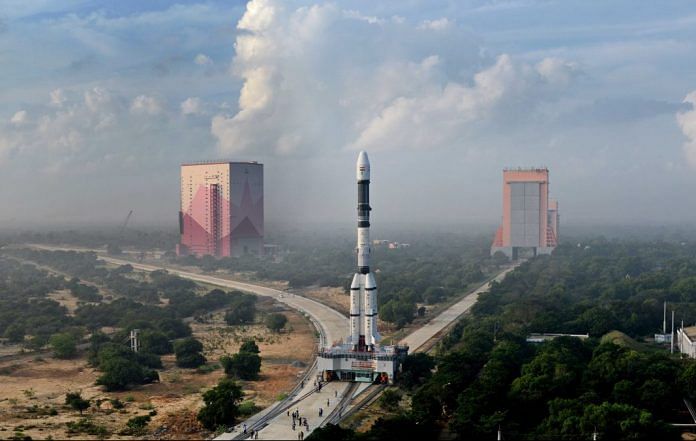The GSAT-7A satellite can detect flying military aircraft and distinguish between friendly and hostile aircraft as well.
Bengaluru: The Indian Space Research Organisation (ISRO) is set to launch the GSAT-7A, one of India’s most advanced military satellites, on board a GSLV Mk II rocket Wednesday.
The 2,250-kg operational communication satellite, to be used by the Indian Air Force and the Indian Army, is modelled on the GSAT-7 satellite built for the Indian Navy.
The satellite will be launched from Sriharikota’s Second Launch Pad at 4:10 pm IST Wednesday. It will be placed by the rocket into a geosynchronous transfer orbit (GTO) at 170 km x 35,000 km. It will then perform orbital manoeuvres for a few days to raise itself to a geostationary orbit (GEO), which will be its final orbiting position at 35,786 km.
What the satellite can do
GSAT-7A will be operated primarily by the IAF, while 30 per cent of its capacity will be shared by the Army. It is the country’s second dedicated defence satellite after the GSAT-7. GSAT-7B is expected to be built soon, primarily for the Army, while the subsequent GSAT-7C will boost all operations.
GSAT-7A is a Ku-band military communications satellite. It contains four solar panels that will provide 3.3 kilowatts of electric power. It is configured using ISRO’s I-2K bus, and will downlink to multiple ground stations across the country.
The satellite also has airborne early warning and control (AEW&C) capabilities. This means that it can detect flying military aircraft, and can then coordinate with other aircraft over the country, especially in airborne battle scenarios. It can distinguish between friendly and hostile aircraft as well.
It is also specially created for remote pilot operations. The satellite will provide a boost for drones and UAV operations.
The satellite has enough chemical propulsion to power it for eight years, which is the expected lifespan of the mission as well.
Also read: The militaristic claims of ISRO’s latest satellite have been greatly exaggerated
GSLV Mk II
The GSLV Mk II is one of the heaviest launch vehicles in India. It is 51 m tall and weighs 421,000 kg. It can carry a payload weighing 5,000 kg to the low earth orbit (at 600 km) and 2,000 kg to the higher geosynchronous transfer orbit (35,000 km).
It has three stages: The first core stage is 20 m tall and will contain a solid fuel motor carrying 139,000 kg fuel. It will be flanked by four liquid fuel boosters, each 19 m tall and containing 42,000 kg liquid propellant. The 12 m high second stage, powered by high thrust Vikas engines, sits above it with liquid fuel. The 9.8 m tall third cryogenic upper stage uses liquid hydrogen and liquid oxygen for fuel.
On top of the third stage is the satellite, within the 3.4 m diameter protective nosecone or ‘payload fairing’, which gets discarded as soon as the rocket leaves the earth’s atmosphere.
This will be the GSLV Mk II’s eighth flight, after one failure and six successes since its first launch in 2010. Its predecessor, the Mk I, had two successes, two failures and two partial failures between 2001 and 2010.




At the outset my best wises to the Team ISRO for the launch of GSAT 7 A on 19-12-2018. The launch of the GSAT 7 A and its subsequent versions which are scheduled later would essentially build up the military combat capabilities of our army . The GSAT 7 A is considered as a technological necessity as it enormously empowers our army with the upgraded satellite communication eco-system viz in the effective use of drones and UAV operations. In my view the GSAT 7 A looks like a versatile communication satellite which will be capable of ensuring an encompassing connect with the various ground monitoring stations in the country. The nation just celebrated the Army day on 7th December 2018 and the launch of GSAT 7 A will be considered as yet another feather in the cap of our army and ISRO too.
Jai ho ISRO and Indian Army
G.Ramasubramanyam.
Vijayawada , AP